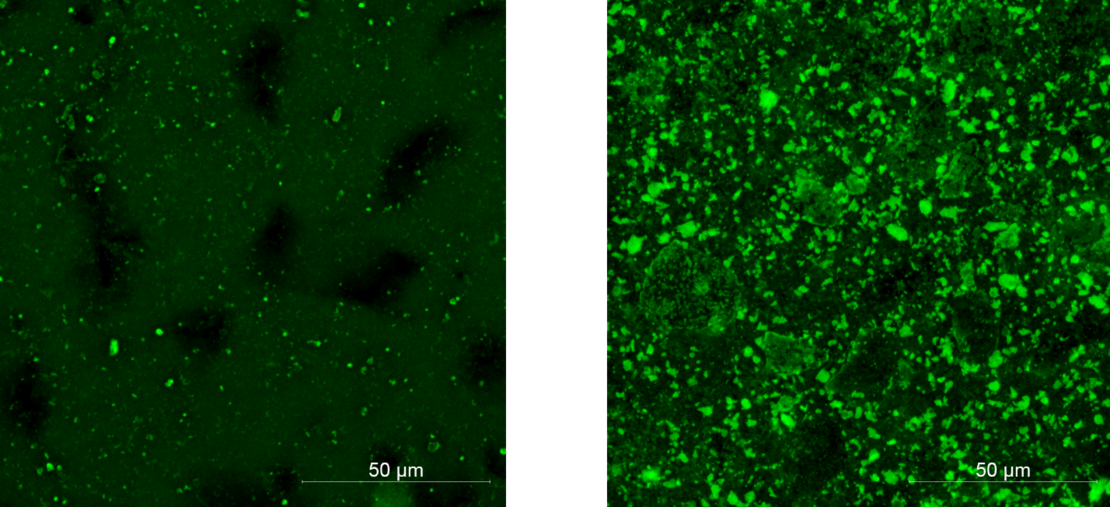Structural Materials and Construction Chemistry
Fluorescence microscopic investigations of superplasticizers for inorganic binding materials
The investigation of the interaction of superplasticizer molecules with different particles in mineral binders is an important part of Dr. Wetzel’s research. Comb-shaped superplasticizer polymers adsorb to the particles, disturb attractive forces between the particles and thus cause a homogenous dispersion and mixture. Especially for high and ultra-high performance concretes (HPC and UHPC), these admixtures are very important to achieve the typical material properties like high compressive strength and durability. The in-situ detection of the polymers is developed in a DFG-project (389127734) to investigate various experimental parameters concerning the polymers-particle-interaction by fluorescence microscopic approaches. The assumed correlation of the microscopic results to the plasticizing effect of an applied concrete succeeded Arend et al. (2018). The main research goal is to predict the characteristics of concrete mixtures like flowability and setting-behaviour with different superplasticizers by fluorescence microscopic adsorption measurements, to establish a resource-conserving and tailored method for further superplasticizer improvement.
The images below, taken with the confocal laser-scanning microscope (CLSM) in the group of Prof. Mueller (biology), show the increasing adsorption of stained superplasticizer with hydration products, formed during the first minutes of cement-hydration. This time dependent development is very important for certain applications of concrete like concrete for transportation or precast elements.

Project-related Publication
J. Arend, A. Wetzel, B. Middendorf. In-situ investigation of superplasticizers: From fluorescence microscopy to concrete rheology. Cement and Concrete Research 2018, 178–185.
Ultra High Performance Concrete with alkali activated Materials – Influence of Silica-fume and Nano-Silica
Alkali activated materials (AAM) are considered a promising alternative to cementitious systems. The production of traditional Portland cement is energy intensive and contributes significantly to CO2 emissions, on this account climate-friendly binder systems are of great interest in the development of building materials. The aim is to dispense with the use of Portland cement clinker and to produce a comparable binder system by suitable use of secondary raw materials.
Based on the principles of ultra-high performance concrete (UHPC) a Portland cement free, alkali-activated material was developed and the effects of silica fume and nano-silica on the fresh and hardened concrete properties were investigated (Wetzel et al. 2019). These are inorganic, mineral, non-metallic binders with a high content of reactive silicon (Si) and aluminum (Al) and optionally calcium (Ca). While the use of superplasticizers is necessary in the UHPC due to the addition of silica fume, the AAB has observed a rheology optimization with silica fume at compressive strengths of in the range of 200 MPa after 56 days. Whether this results from a ball-bearing effect of the very fine spherical particles (Fig. 2) or a chemical reaction is investigated under variation of silica fume content.
The pure substitution of silica fume by nano-silica particles showed no improvement in the rheological properties. After the addition of the activating solution a greatly delayed liquefaction effect was also observed, which can be attributed to the morphology of the nano-silica particles. This nano-silica is present as agglomerates and characterized by small nano-sized pores (Fig. 3). Due to the network structure, the activation solution is first bound and SiO2 particles dissolved. The hydration- and polymerization reactions then release water that can subsequently react with the structures of the slag. Investigations of the binders in situ with the Fourier transform infrared spectroscope have also provided information on the different solution processes. It has been observed that the rheological properties due to the use of silica fume are not only due to the ball-bearing effect. The chemical reaction of the silica particles and the associated solution- and polymerization process also have an influence on these properties.


Project-related Publication
Wetzel, B. Middendorf. Influence of silica fume on properties of fresh and hardened ultra-high performance concrete based on alkali activated slag. Cement and Concrete Composites 100, 2019, 53-59.
Dr. Alexander Wetzel
associate member

- Location
- Universität Kassel
Fachbereich 14 - Bauingenieur- & Umweltingenieurwesen
Institut für konstruktiven Ingenieurbau
Mönchebergstr. 7
34125 Kassel
- Room
- 1106
